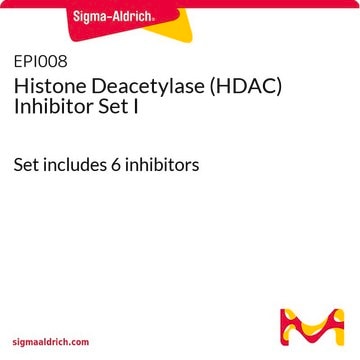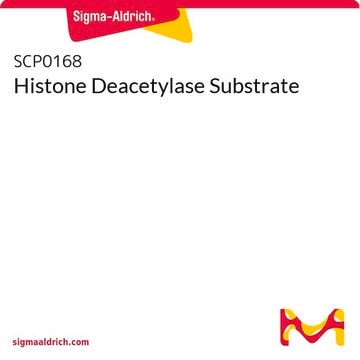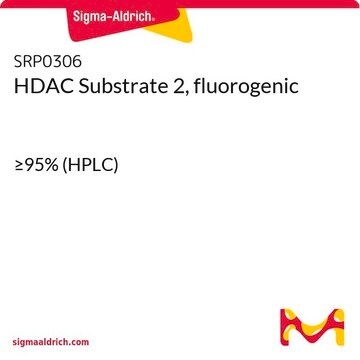推荐产品
一般描述
Histone deacetylases (HDACs) are a large family of enzymes that remove acetyl groups from histone proteins. Site specific histone acetylation and deacetylation have been shown to activate or repress eukaryotic gene transcription, respectively, and as a consequence, HDACs play a crucial role in mammalian development and disease. HDACs are involved in important biological activities, such as cell differentiation, proliferation, apoptosis, and senescence.
With Sigma′s HDAC8 Inhibitor Screening Kit, HDAC8 Enzyme acts with the supplied Developer to deacetylate and then cleave the HDAC8 Substrate (R-H-K(Ac)-K(Ac)-AFC). This activity releases the quenched fluorescent group, AFC, which can be detected at Em/Ex=380/500 nm. In the presence of a HDAC8 inhibitor, AFC is not released and its fluorescence remains quenched. The kit provides a rapid, simple, sensitive, and reliable test, suitable for either individual tests or high throughput screening of HDAC8 inhibitors. Trichostatin A (TSA) is included as a control inhibitor to compare with the efficacy of test inhibitors.
With Sigma′s HDAC8 Inhibitor Screening Kit, HDAC8 Enzyme acts with the supplied Developer to deacetylate and then cleave the HDAC8 Substrate (R-H-K(Ac)-K(Ac)-AFC). This activity releases the quenched fluorescent group, AFC, which can be detected at Em/Ex=380/500 nm. In the presence of a HDAC8 inhibitor, AFC is not released and its fluorescence remains quenched. The kit provides a rapid, simple, sensitive, and reliable test, suitable for either individual tests or high throughput screening of HDAC8 inhibitors. Trichostatin A (TSA) is included as a control inhibitor to compare with the efficacy of test inhibitors.
特点和优势
- Simple, sensitive, and reliable assay
- Simple procedure; takes ~60 min
- Utilizes fluorometric methods
- Sample type: candidate HDAC8 inhibitors
- Suitable for screening HDAC8 inhibitors
- Suitable for individual tests or high throughput assays
- Convenient 96-well microplate format
相关产品
产品编号
说明
价格
储存分类代码
10 - Combustible liquids
WGK
WGK 3
闪点(°F)
188.6 °F - closed cup
闪点(°C)
87 °C - closed cup
Bihua Bie et al.
Nature neuroscience, 17(2), 223-231 (2014-01-21)
Amyloid-induced microglial activation and neuroinflammation impair central synapses and memory function, although the mechanism remains unclear. Neuroligin 1 (NLGN1), a postsynaptic protein found in central excitatory synapses, governs excitatory synaptic efficacy and plasticity in the brain. Here we found, in
Ji Heon Noh et al.
Cancer research, 74(6), 1728-1738 (2014-01-23)
Aberrant regulation of histone deacetylase 2 (HDAC2) contributes to malignant progression in various cancers, but the underlying mechanism leading to the activation of oncogenic HDAC2 remains unknown. In this study, we show that HDAC2 expression is upregulated in a large
Astrid M Kral et al.
Biochemistry, 53(4), 725-734 (2014-01-24)
Histone deacetylases (HDACs) play diverse roles in many diseases including cancer, sarcopenia, and Alzheimer's. Different isoforms of HDACs appear to play disparate roles in the cell and are associated with specific diseases; as such, a substantial effort has been made
Yong Wang et al.
Circulation research, 114(6), 957-965 (2014-01-31)
Our previous study has shown that yes-associated protein (YAP) plays a crucial role in the phenotypic modulation of vascular smooth muscle cells (SMCs) in response to arterial injury. However, the role of YAP in vascular SMC development is unknown. The
Li-Sophie Z Rathje et al.
Proceedings of the National Academy of Sciences of the United States of America, 111(4), 1515-1520 (2014-01-30)
Oncogenes deregulate fundamental cellular functions, which can lead to development of tumors, tumor-cell invasion, and metastasis. As the mechanical properties of cells govern cell motility, we hypothesized that oncogenes promote cell invasion by inducing cytoskeletal changes that increase cellular stiffness.
Active Filters
我们的科学家团队拥有各种研究领域经验,包括生命科学、材料科学、化学合成、色谱、分析及许多其他领域.
联系技术服务部门







